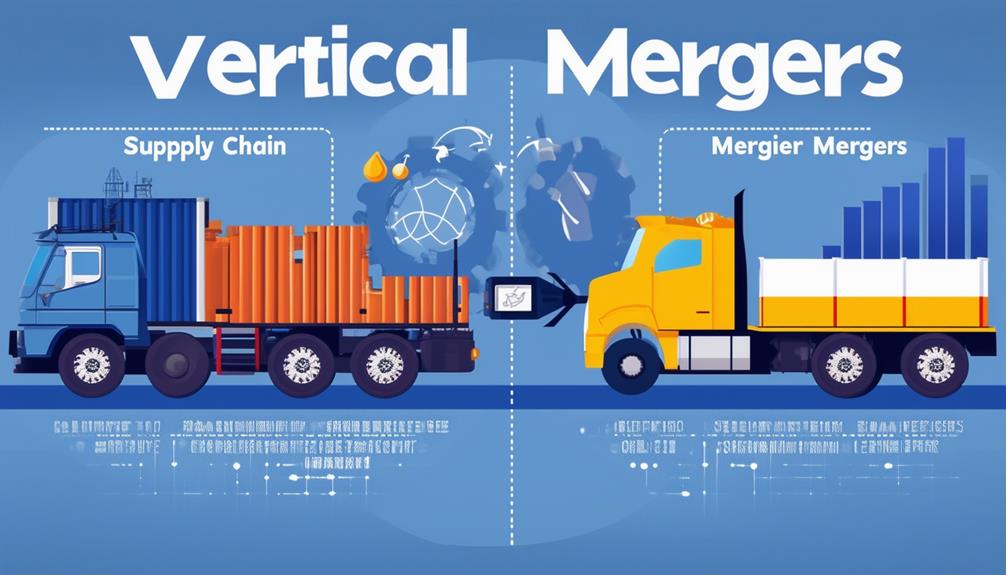Vertical Mergers: A Case Study Analysis

Vertical mergers, such as Apple's integration from chip manufacturing to software development, optimize operations, reduce costs, and enhance quality control in industries.
Amazon's vertical model excels in streamlining the supply chain, cutting expenses, and fostering innovation.
Tesla's vertical integration boosts efficiency, quality, and innovation through enhanced control.
Ford's vertical alignment ensures cost savings, efficiency, quality control, and agility in meeting market demands.
Procter & Gamble's strategic approach emphasizes agility, efficiency, quality, innovation, and brand loyalty.
These case studies showcase the significant impact of vertical mergers on various sectors, providing valuable insights into improved performance and competitiveness.
Key Takeaways
Vertical mergers are like puzzle pieces that fit perfectly together, optimizing supply chains and enhancing operational efficiency and control. By bringing different stages of production under one roof, companies can streamline processes, reduce costs, and drive innovation and adaptation. This strategic move not only strengthens market competitiveness but also fosters a culture of collaboration and synergy within the organization.
Apple's Vertical Integration
Apple's vertical integration strategy, incorporating hardware, software, and services seamlessly, serves as a foundational element of its success in the tech industry. By overseeing every aspect of production, from designing its own chips for iPhones to managing software development, Apple achieves remarkable efficiency gains throughout its supply chain. This tight integration enables Apple to streamline processes, reduce costs, and uphold stringent quality control standards.
This integration not only enhances Apple's efficiency but also shapes the market structure in which it operates. By controlling the entire ecosystem, Apple creates a distinct customer experience that cultivates high levels of loyalty and satisfaction. This strategy has solidified Apple's position as a leader in the tech industry and contributed significantly to its immense value as a company. As a result, Apple's vertical integration serves as a model for how businesses can optimize their operations by aligning hardware, software, and services under one unified vision.
Amazon's Vertical Integration
Amazon's vertical integration strategy, covering control from production to distribution, is a key factor in the company's operational success and global retail dominance. By acquiring product lines like Amazon Echo and Fire TV, Amazon utilizes vertical mergers to streamline its supply chain, cut shipping costs, and boost operational efficiency.
This not only cements Amazon's position as one of the largest retailers globally but also gives the company greater oversight of its supply chain, ensuring smoother operations and better customer experiences. Through vertical mergers, Amazon has created a seamless process from manufacturing to delivery, allowing the company to adapt quickly to market demands and drive innovation.
This integrated approach not only propels Amazon's expansion but also sets a standard for operational excellence in the retail sector, demonstrating the impact of strategic vertical mergers on achieving global success.
Zara's Vertical Integration

Vertical integration is key to Zara's operational strategy, allowing the brand to oversee every aspect of its product development and distribution processes. Zara is a vertically integrated company, meaning it handles the design, manufacturing, and distribution of its products in-house. This approach enables Zara to quickly adapt to trends and meet customer demands in the fast-paced fashion industry.
By controlling the entire production process, Zara can efficiently manufacture its products, enhancing its competitiveness. Moreover, this vertical integration empowers Zara to maintain high-quality standards and introduce innovations in its product line. The seamless coordination of design, manufacturing, and distribution plays a vital role in building customer loyalty and driving profitability for Zara.
This strategic alignment not only simplifies operations but also reduces the problem of double marginalization while providing greater control over input prices. Zara's vertical integration model illustrates how a well-planned integration strategy can lead to operational excellence and long-term success in the fashion retail sector.
Tesla's Vertical Integration
Tesla's vertical integration strategy significantly boosted their production efficiency and overall performance. By overseeing the entire production process, from battery manufacturing to assembly, Tesla has streamlined operations and cut costs. This approach hasn't only increased profitability but also enabled Tesla to uphold superior quality standards and foster innovation in the electric vehicle market.
Vertical mergers, like the one Tesla has implemented, involve the combination of companies operating at different stages of the same supply chain. This type of merger allows for better coordination and control over the production process, leading to improved efficiency and cost savings.
In the realm of mergers and acquisitions, vertical integration stands out as a strategic move that has the potential to reshape industries and drive competitiveness. By integrating different stages of production under one roof, companies like Tesla can enhance their market position and capitalize on synergies that benefit both the business and consumers alike.
Tesla's Production Efficiency
Controlling the entire production process of electric vehicles has empowered Tesla to significantly enhance their manufacturing efficiency and cost-effectiveness. This strategic vertical integration approach encompasses in-house battery production and vehicle assembly, enabling Tesla to innovate rapidly and uphold high-quality standards. Here are four key points highlighting Tesla's production efficiency:
- Streamlined Operations: Tesla's vertical integration streamlines the production process by removing the reliance on external suppliers for critical components.
- Cost Reduction: By manufacturing batteries in-house, Tesla diminishes costs linked to outsourcing and transportation, leading to overall cost savings.
- Quality Control: Maintaining control over the entire production chain allows Tesla to uphold stringent quality control measures, ensuring consistent product standards.
- Innovation Acceleration: Through vertical integration, Tesla can innovate more efficiently, introducing technological advancements faster than competitors dependent on external partners.
Tesla's dedication to vertical integration hasn't only optimized their production efficiency but also positioned them as a leader in the automotive industry's transition towards sustainable transportation solutions.
Benefits of Integration
By opting for vertical mergers across its production process, Tesla has gained significant advantages. This strategic approach hasn't only boosted efficiency but has also provided Tesla with a higher degree of control over its operations, fostering a culture of innovation within the company.
Through vertical mergers, Tesla has maintained exceptional quality standards in its electric vehicles, distinguishing itself in the automotive industry. The streamlined operations resulting from this strategy have optimized production control, enabling Tesla to swiftly adapt to market demands and technological advancements.
Embracing vertical mergers has led to cost reductions for Tesla, enhancing its competitive advantage and cementing its position as a market leader. The benefits of Tesla's vertical mergers go beyond mere efficiency, illustrating how a comprehensive approach to production can stimulate innovation and success in the automotive sector.
Netflix's Vertical Integration

Netflix's vertical integration strategy, encompassing content production and streaming platform management, has propelled the company to the forefront of the entertainment industry. Here are four key points illustrating the impact of Netflix's vertical integration:
- Enhanced Control: Netflix's vertical integration allows it to control the entire production process, from content creation to delivery, ensuring a seamless and high-quality customer experience.
- Exclusive Content: Through vertical integration, Netflix can offer unique content that distinguishes it from competitors, attracting and retaining subscribers looking for distinctive and captivating entertainment options.
- Value Proposition: By owning and creating its content, Netflix enhances its value proposition to subscribers, providing a wide range of shows and movies tailored to different preferences.
- Market Leadership: Netflix's success in vertical integration is evident in its global popularity and dominant position in streaming services, demonstrating how this strategy has cemented its status as an industry leader.
Ford's Vertical Integration
Ford's vertical integration involves controlling the entire production process in the automotive industry. This strategy has resulted in cost savings, improved efficiency, and a strong competitive edge for Ford. By managing production internally, Ford ensures quality control, encourages innovation, and quickly responds to market needs.
Vertical mergers, like the one Ford has implemented, occur when a company acquires or merges with a business within the same industry but at a different stage of the production process. This can lead to synergies, streamlined operations, and increased market power. In Ford's case, their vertical integration has allowed them to have more control over their supply chain, from manufacturing to distribution, giving them a strategic advantage in the automotive market.
Mergers and acquisitions in the automotive industry are common strategies for companies looking to strengthen their position in the market. By integrating vertically, Ford has positioned itself as a leader in the industry, setting a trend for other companies to follow. This approach has proven to be successful for Ford, as they continue to innovate, adapt to market trends, and maintain their competitive edge.
Ford's Supply Chain
Ford's strategic approach to vertical integration involves controlling multiple stages of its supply chain, which contributes significantly to its operational efficiency and competitive position in the automotive sector. Here are four primary ways in which Ford's supply chain management via vertical integration drives innovation and competitiveness:
- Quality Assurance: By overseeing manufacturing, distribution, and retail processes, Ford ensures that its products adhere to stringent quality standards, enhancing customer satisfaction and bolstering its brand image.
- Cost Efficiency: Vertical integration enables Ford to streamline its operations, eliminate inefficiencies, and reduce unnecessary costs, ultimately boosting profitability and strengthening its competitive stance.
- Agile Adaptation: Through a tightly integrated supply chain, Ford can swiftly respond to market dynamics and consumer trends, swiftly introducing new products or adjusting production schedules as needed.
- Innovation Catalyst: By owning various facets of its supply chain, Ford cultivates an environment that fosters innovation, allowing the company to lead in technological advancements and product development, thereby enhancing its competitive edge in the industry.
Manufacturing Efficiency
By vertically integrating its operations, Ford has taken full control of the production process, from manufacturing to distribution. This strategic move has allowed Ford to minimize costs and enhance operational efficiency. By handling all stages internally, Ford can streamline production and respond swiftly to market needs. This approach not only helps Ford save money but also boosts its capacity for innovation in the automotive sector.
Ford's vertical integration strategy has enabled the company to maintain rigorous quality control throughout its manufacturing processes, ensuring that its products consistently meet top-notch standards. Furthermore, this integration has granted Ford significant power in the upstream market, enabling the company to influence prices and retain a competitive advantage.
While critics might raise concerns about potential anti-competitive effects or price discrimination resulting from such vertical mergers, Ford's successful implementation showcases the benefits of maximizing manufacturing efficiency through vertical integration.
Competitive Advantage
Our analysis clearly demonstrates the significant competitive edge achieved through vertical integration in the automotive industry. Here are four key points that highlight the competitive advantage Ford has gained through its integrated approach:
- Efficiency Boost: By controlling the entire production process, Ford can streamline operations, reduce inefficiencies, and enhance overall productivity.
- Quality Control: Vertical integration enables Ford to uphold strict quality standards at every production stage, ensuring only top-notch products reach the market.
- Innovation Implementation: Through vertical integration, Ford can effortlessly introduce cutting-edge practices and technologies into its operations, staying ahead of competitors.
- Cost Management: The integrated model empowers Ford to efficiently manage costs throughout the value chain, boosting profitability and long-term sustainability.
Procter & Gamble's Vertical Integration

Procter & Gamble's strategic vertical mergers have significantly boosted its ability to adapt quickly to shifting consumer demands. With direct control over production processes, the company ensures heightened efficiency, enabling timely delivery of products to consumers. This cohesive approach not only simplifies operations but also drives up profitability for Procter & Gamble.
Through vertical mergers, Procter & Gamble upholds rigorous quality control standards across the production line, fostering a culture of continual innovation and enhancement. This not only benefits the company internally but also resonates with consumers, fostering stronger brand loyalty. By integrating diverse production stages, Procter & Gamble crafts products that meet the highest quality benchmarks, ultimately fueling customer satisfaction and loyalty.
Frequently Asked Questions
What Is a Vertical Merger Case?
In a vertical merger case, firms from different levels of the supply chain come together. This type of merger can bring about advantages such as increased efficiency, but it can also present challenges like the risk of market foreclosure. Understanding how these mergers impact competition and consumer welfare is crucial for making strategic decisions in the business world.
What Is a Real Life Example of a Vertical Merger?
Vertical mergers have been instrumental in reshaping industries and creating new opportunities for growth. Examples like Amazon's acquisition of Whole Foods, CVS merging with Aetna, Verizon's purchase of Yahoo, and AT&T combining with Time Warner showcase the transformative power of vertical integration. These mergers have allowed companies to streamline operations, expand their market reach, and offer more comprehensive services to consumers.
Amazon's acquisition of Whole Foods, for instance, allowed the e-commerce giant to enter the brick-and-mortar retail space and strengthen its presence in the grocery industry. By combining their resources and expertise, Amazon and Whole Foods were able to enhance the shopping experience for customers and drive innovation in the sector.
Similarly, the merger between CVS and Aetna brought together a pharmacy chain and a health insurance provider to create a more integrated healthcare delivery system. This vertical integration not only improved access to healthcare services for customers but also led to cost savings and operational efficiencies for the merged entity.
Verizon's acquisition of Yahoo enabled the telecommunications company to diversify its offerings and enter the digital media and advertising market. By integrating Yahoo's online properties and advertising technology with its own network infrastructure, Verizon was able to create new revenue streams and compete more effectively in the digital space.
Lastly, the merger of AT&T and Time Warner brought together a telecommunications giant and a media conglomerate to create a powerhouse in the entertainment industry. This vertical integration allowed the merged entity to produce and distribute content across various platforms, giving consumers more choices and driving innovation in the media landscape.
What's the Most Common Reason for a Vertical Merger?
Vertical mergers are commonly pursued to streamline operations, eliminate duplicate processes in the supply chain, and increase overall efficiency. The primary goal is to enhance control, reduce costs, and ultimately drive up profitability. By integrating different stages of production or distribution, companies can achieve synergy and establish a stronger position in the market.
Vertical integration allows companies to have a more seamless flow of goods or services, leading to improved coordination and reduced complexities in the business. This strategy not only helps in avoiding middlemen but also enables better decision-making and quicker responses to market changes. Ultimately, it can result in a more competitive edge and greater market dominance.
Historically, vertical mergers have been used by companies to gain a strategic advantage and strengthen their position in the industry. By combining complementary businesses, organizations can create a more cohesive and efficient operation that is better equipped to meet customer demands and adapt to market trends. This approach has been proven effective in various sectors, from manufacturing to retail, where companies have successfully leveraged vertical integration to drive growth and maximize profits.
Is Disney and Pixar a Horizontal or Vertical Merger?
Disney and Pixar epitomize a vertical merger, uniting distinct levels of the supply chain. This strategic move has bolstered market competition, streamlined operations, and necessitated careful navigation of regulatory frameworks. By joining forces, the alliance has harnessed the synergies between distribution, animation, and storytelling expertise, paving the way for unprecedented creative collaborations and business growth.
Conclusion
In conclusion, vertical mergers have proven to be a strategic move for companies like Apple, Amazon, Zara, Tesla, Netflix, Ford, and Procter & Gamble. These integrations have allowed them to streamline operations, control costs, and enhance product offerings.
The impact of vertical mergers on these companies is truly remarkable, transforming their industries and cementing their positions as market leaders. The significance of vertical integration can't be overstated, as it continues to shape the landscape of modern business.





